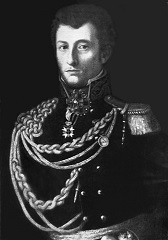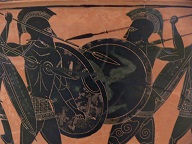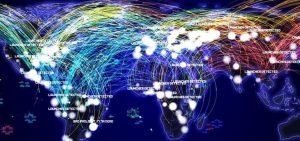[Editor’s Note: Mad Scientist Laboratory is pleased to publish yet another in our series of “The Tenth Man” posts (read our previous posts here and here). This Devil’s Advocate or contrarian approach serves as a form of alternative analysis and is a check against group think and mirror imaging. The Mad Scientist Laboratory offers it as a platform for the contrarians in our network to share their alternative perspectives and analyses regarding the Future Operational Environment. Today’s post is by guest blogger Dr. Peter Layton, challenging the commonly held belief of the persistent and abiding nature of war.]
 There’s a debate underway about the nature of war. Some say it’s immutable, others say hogwash; ironically both sides quote Clausewitz for support.[i] Interestingly, Secretary of Defense Mattis, once an ‘immutable’ defender, has now declared he’s not sure anymore, given recent Artificial intelligence (AI) developments.[ii]
There’s a debate underway about the nature of war. Some say it’s immutable, others say hogwash; ironically both sides quote Clausewitz for support.[i] Interestingly, Secretary of Defense Mattis, once an ‘immutable’ defender, has now declared he’s not sure anymore, given recent Artificial intelligence (AI) developments.[ii]
At the core of the immutable case is the belief that war has always been violent, chaotic, destructive, and murderous – and will thus always be so. Buried within this is the view that wars are won by infantry occupying territory; as  Admiral Wylie opined “the ultimate determinant in war is a man on the scene with a gun.”[iii] It is the clash of infantry forces that is decisive, with both sides experiencing the deadly violence of war in a manner that would have been comprehendible by Athenian hoplites 2,500 years ago.
Admiral Wylie opined “the ultimate determinant in war is a man on the scene with a gun.”[iii] It is the clash of infantry forces that is decisive, with both sides experiencing the deadly violence of war in a manner that would have been comprehendible by Athenian hoplites 2,500 years ago.
Technology though really has changed this. Firstly, the lethality of modern weapons has emptied out the battlefield.[iv] What can be ‘seen’ by sensors of diverse types can be targeted by increasingly precise direct and indirect fires. The Russo-Ukraine war in the Donbas hints that in future wars between state-based military forces, tactical units will need to remain unseen to survive and that they will now ‘occupy’ territory principally through long-range firepower.[v]  Secondly, Phillip Meilinger makes a strong case that drone crews firing missiles at insurgents from 3,000 miles away or navies blockading countries and staving their people into submission do not experience war the same as those hoplite infantry did years ago.[vi] The experience of violence in some wars has become one-sided, while wars are now increasingly waged against civilians well behind any defensive front lines.
Secondly, Phillip Meilinger makes a strong case that drone crews firing missiles at insurgents from 3,000 miles away or navies blockading countries and staving their people into submission do not experience war the same as those hoplite infantry did years ago.[vi] The experience of violence in some wars has become one-sided, while wars are now increasingly waged against civilians well behind any defensive front lines.

AI may deepen both trends. AI has the potential to sharply enhance the defense continuing to empty out the battlefield, turning it into a no-man’s zone where automated systems and semi-autonomous devices wage attrition warfare.[vii] If both sides have intelligent machines, war may become simply a case of machines being violent to other machines. In a re-run of World War One, strategic stalemate would seem the likely outcome with neither side able to win meaningful battlefield victories.[viii]
 If so, the second aspect of war’s changing nature comes into play. If a nation’s borders cannot be penetrated and its critical centers of gravity attacked using kinetic means, perhaps non-kinetic means are the offensive style of the future. Indeed, World War One’s battlefield stalemate was resolved as the naval blockade caused significant civilian starvation and the collapse of the homefront.
If so, the second aspect of war’s changing nature comes into play. If a nation’s borders cannot be penetrated and its critical centers of gravity attacked using kinetic means, perhaps non-kinetic means are the offensive style of the future. Indeed, World War One’s battlefield stalemate was resolved as the naval blockade caused significant civilian starvation and the collapse of the homefront.
 The application of information warfare by strategic competitors against the US political system hints at new cyber techniques that AI may greatly enhance.[ix] Instead of destroying another’s capabilities and national infrastructures, they might be exploited and used as bearers to spread confusion and dissent amongst the populace. In this century, starvation may not be necessary to collapse the homefront; AI may offer more efficacious methods. War may no longer be violent and murderous but it may still be as Clausewitz wrote a “true political instrument.”[x] Secretary Mattis may be right; perhaps war’s nature is not immutable but rather ripe for our disruption and innovation.
The application of information warfare by strategic competitors against the US political system hints at new cyber techniques that AI may greatly enhance.[ix] Instead of destroying another’s capabilities and national infrastructures, they might be exploited and used as bearers to spread confusion and dissent amongst the populace. In this century, starvation may not be necessary to collapse the homefront; AI may offer more efficacious methods. War may no longer be violent and murderous but it may still be as Clausewitz wrote a “true political instrument.”[x] Secretary Mattis may be right; perhaps war’s nature is not immutable but rather ripe for our disruption and innovation.
If you enjoyed this guest post, please also read proclaimed Mad Scientist Dr. Lydia Kostopoulos’ paper addressing this topic, entitled War is Having an Identity Crisis, hosted by our colleagues at Small Wars Journal.
 Dr. Peter Layton is a Visiting Fellow at the Griffith Asia Institute, Griffith University. A former RAAF Group Captain, he has extensive defense experience, including in the Pentagon and at National Defense University. He holds a doctorate in grand strategy. He is the author of the book ‘Grand Strategy.’
Dr. Peter Layton is a Visiting Fellow at the Griffith Asia Institute, Griffith University. A former RAAF Group Captain, he has extensive defense experience, including in the Pentagon and at National Defense University. He holds a doctorate in grand strategy. He is the author of the book ‘Grand Strategy.’
[i] For the immutable, see Rob Taber (2018), Character vs. Nature of Warfare: What We Can Learn (Again) from Clausewitz, Mad Scientist Laboratory, 27 August 2018. For the mutable, see Phillip S. Meilinger (2010), The Mutable Nature of War, Air & Space Power Journal, Winter 2010, pp 25-28. For Clausewitz (both sides), see Dr. A.J. Echevarria II (2012), Clausewitz and Contemporary War: The Debate over War’s Nature, 2nd Annual Terrorism & Global Security Conference 2012.
[ii] Aaron Mehta (2018), AI makes Mattis question ‘fundamental’ beliefs about war, C4ISRNET, 17 February 2018.
[iii] J.C. Wylie (1967), Military Strategy: A General Theory of Power Control, New Brunswick, Rutgers University Press, p. 85.
[iv] James J Schneider (1987), The theory of the empty battlefield, The RUSI Journal, Vol. 132, Issue 3, pp. 37-44.
[v] Brandon Morgan (2018), Artillery in Tomorrow’s Battlefield: Maximizing the Power of the King of Battle, Modern War Institute, 25 September 2018.
[vi] The Mutable Nature of War: The Author Replies, Air & Space Power Journal, Summer 2011, pp 21-22. And also: Phillip S. Meilinger (2010), The Mutable Nature of War, Air & Space Power Journal, Winter 2010, pp 25-28.
[vii] Peter Layton (2018), Our New Model Robot Armies, Small Wars Journal, 7 August 2018.
[viii] Peter Layton (2018), Algorithm Warfare: Applying Artificial Intelligence to Warfighting, Canberra: Air Power Development Centre, pp. 31-32.
[ix] Renee Diresta (2018), The Information War Is On. Are We Ready For It? , Wired, 3 August.
[x] Carl Von Clausewitz, On War, Edited and Translated by Michael Howard and Peter Paret (1984), Princeton: Princeton University Press, p.87.




At one extreme, the future concept of warfare is a sporting contest or a video game. At the other, the horror of war extends to a conflict between nations including all civilians not just the paladins of war, resulting in massive loss of combatant and noncombatant life. The march of technology changes the means of applying force whether economic, psychological, social or military. War is the ultimate failure of diplomacy and the last course for imposition of national goals. In any future, the means of changing obdurate opinion ends in conflict when diplomacy fails. Denial of economic sustenance, basic necessities like food and shelter, disruption of economic pursuits, loss of life and loss of the means of self-sufficiency lead to cultural stress and ultimately to war. Uniform distribution of any commodity fails at the point where demand outstrips supply and a difference of the value ensues. Wars of ideology go beyond simple economic or domestic need. Polar opposition of ideology generates a deteriorating spiral of discontent. War, limited or not, results from the strains of such evolutionary responses to change. In a war of robots, the loss of life may be controlled but as populations grow there are limitations on the supply of resources resulting in internecine conflict. Warfare is inevitable and perhaps even Darwinian in the most brutal sense.
Artificial Intelligence will not affect the loss of life that is endemic in resolution of conflict where powers contest. Complex algorithms form the basis of many civilian and military systems and the fifth rise of proponents for artificial intelligence since WWII may have small impacts in several areas such as image analysis and to a lesser extent, logistics. Many changes will be from the limitation or elimination of repetitive activities that should have been reduced or replaced decades ago. Notions of dense urban conflict, guerrilla warfare and asymmetric attacks take advantage of natural camouflage in daily life. Unsuspected violence erupts from actors not identified by conventional warfare means. As an additional consideration, the means to disrupt electronics in battle have long been known evoking escalations of warfare. The threat of uncivilized solutions to civil contest do not seem to have diminished. The result may be significantly greater loss of life in direct conflict from long range weapons and unconventional warfare as the means of war disrupt or destroy the electronic tools of warfare. Societal trends, moving toward larger cities or widely dispersed geographic/global industrial operations may increase the scale of global devastation and enhance the damage done by even minor conflicts. It would seem that electronics and related materiel may contest to initiate conflict but the work of establishing change and maintaining the peace will fall to the boots on the ground and voices that support them.
Thanks for the interesting thoughts. I agree that the big impact – at least initially – from AI, robots and autonomy will be on enhancing productivity. As in earlier phases of the the industrial and IT revolution, fewer people will be able to do more. The battlefield continues to empty out. I’m not so sure though about your conclusion that “the work of establishing change and maintaining the peace will fall to the boots on the ground and voices that support them.” I’m not sure peace can be compelled and I argue that over at The Strategy Bridge ‘Using a Clausewitzian Dictum to Rethink Achieving Victory’ May 15, 2018. In the vein of this post though, it is possible to imagine that real change was effected by the Russian interference in the 2016 elections. The margin was so small that its possible Russian efforts were crucial to the election outcomes. NBER also looked at Brexit and found similarly. Both the 2016 election and Brexit results were consequential; they bought change. Its possible future efforts may be even more consequential. Boots on the ground may not always be needed.
Read the recent Small Wars Journal entry “The Feet of the Masters: Lessons on Irregular Cyber Warfare”.
Mattis is correct about war’s immutability. “War” will always exist and has done so since the first “man” clinched a fist at another for dominance.
That SWJ post is a very interesting one. To turn it around, we are now all converts to the virtual world supporting the physical one but we may be moving to conflicts where the physical one supports the virtual one. Actions in the physical world might then be undertaken in such a way as to support virtual world activities that are trying to effect change. That ‘identity’ war argument if you will. Second, just to note Mattis thought the nature of war might now not be immutability. His reading of the impact of AI was leaving him with doubts that war’s nature was as unchanging as some thought.